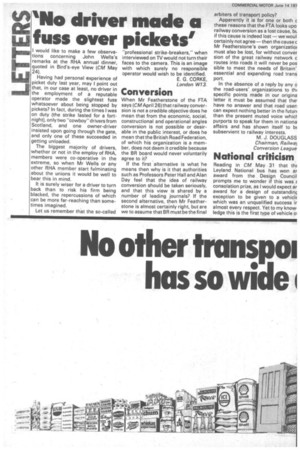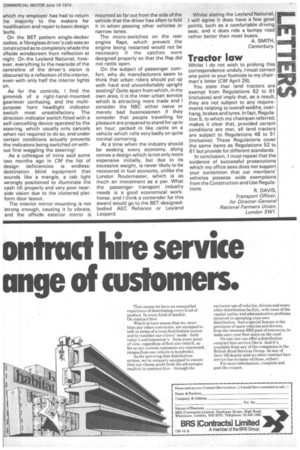'No driver made a fuss over pickets'
Page 68

Page 69

If you've noticed an error in this article please click here to report it so we can fix it.
I would like to make a few observations concerning John Wells's remarks at the RHA annual dinner, quoted in Bird's-eye View (CM May 24).
Having had personal experience of picket duty last year, may I point out that, in our case at least, no driver in the employment of a reputable operator made the slightest fuss whatsoever about being stopped by pickets? In fact, during the times I was on duty (the strike lasted for a fortnight), only two "cowboy" drivers from Scotland, and one owner-driver insisted upon going through the gate, and only one of these succeeded in getting unloaded.
The biggest majority of drivers, whether or not in the employ of RHA, members were co-operative in the extreme, so when Mr Wells or any other RHA member start fulminating about the unions it would be well to bear this in mind.
It is surely wiser for a driver to turn back than to risk his firm being blacked, the repercussions of which can be more far-reaching than sometimes imagined.
Let us remember that the so-called "professional strike-breakers," when interviewed on TV would not turn their faces to the camera. This is an image with which surely no responsible operator would wish to be identified.
E. G. CORKE, London W13.
Conversion
When Mr Featherstone of the FTA says (CM April 26) that railway conversion is not a credible objective does he mean that from the economic, social, constructional and operational angles conversion is not possible or desirable in the public interest, or does he mean that the British Road Federation, of which his organization is a member, does not deem it credible because the BR board would never voluntarily agree to it?
If the first alternative is what he means then why is it that authorities such as Professors Peter Hall and Alan Day feel that the idea of railway conversion should be taken seriously, and that this view is shared by a number of leading journals? If the second alternative, then Mr Featherstone is almost certainly right, but are we to assume that BR must be the final arbiters of transport policy?
Apparently it is for one or both c these reasons that the FTA looks upo railway conversion as a lost cause, bL if this cause is indeed lost—we wout certainly not agree— then the cause c Mr Featherstone's own organizatioi must also be lost, for without conver sion of the great railway network c routes into roads it will never be pos sible to meet the needs of Britain' essential and expanding road trans port.
In the absence of a reply by any o the road-users' organizations to thi specific points made in our origina letter it must be assumed that the, have no answer and that road user can expect nothing better in the futuri than the present muted voice whict purports to speak for them in nationa affairs and has shown itself to Li( subservient to railway interests.
M. J. DOUGLASS Chairman, Railwa Conversion League
National criticism
Reading in CM May 31 that th( Leyland National bus has won ar award from the Design Council prompts me to wonder if this was E consolation prize, as I would expect ar award for a design of outstandinc exception to be given to a vehick which was an unqualified success ir almost every respect. Yet to my knowledge this is the first type of vehicle 01 Nhich my employer has had to return :he majority to the makers for -nodification and repair to basic design 'auks.
On the BET pattern single-decker oodles, a fibreglass driver's cab was so .1i:instructed as to completely shade the offside windscreen from reflection at night. On the Leyland National, however, everything to the nearside of the centreline of the driver's vision is obscured by a reflection of the interior, even with only half the interior lights on.
As for the controls, I find the gimmick of a right-hand-mounted gearlever confusing, and the multipurpose horn headlight indicator switch most unsatisfactory. The direction-indicator switch fitted with a self-cancelling device operated by the steering, which usually only cancels when not required to do so, and under certain conditions actually prevents the indicators being switched on without first waggling the steering!
As a colleague of mine said some two months ago in CM the list of design deficiencies is endless: destination blind equipment that sounds like a mangle, a cab light wrongly positioned to illuminate the cash till properly and very poor nearside vision due to the cluttered platform door layout.
The interior mirror mounting is not strong enough, causing it to vibrate, and the offside exterior mirror is mounted so far out from the side of the vehicle that the driver has often to fold it in when passing other vehicles in narrow lanes.
The micro-switches on the rear engine flaps, which prevent the engine being restarted would not be necessary if the catches were designed properly so that the flap did not rattle open.
On the subject of passenger comfort, why do manufacturers seem to think that urban riders should put up with hard and uncomfortably upright seating? Quite apart from which, in my own area, it is the inter-urban service which is attracting more trade and I consider the NBC either naive or merely bad businessmen if they consider that people travelling for pleasure are prepared to stand for up to an hour, packed in like cattle on a vehicle which rolls very badly on quite normal cornering.
At a time when the industry should be seeking every economy, along comes a design which is not only more expensive initially, but due to its excessive weight, is never likely to be recovered in fuel economy, unlike the London Routemaster, which is as much an investment as a psv. What the passenger transport industry needs is a good economical workhorse, and I think a contender for this award Would go to the BET-designedbodied AEC Reliance or Leyland Leopard. Whilst slating the Leyland National, I will agree it does have a few good points, such as a comfortable driving seat, and it does ride a bumpy road rather better than most buses.
A. SMITH, Canterbury.
Tractor law
Whilst I do not wish to prolong this correspondence unduly, I must correct one point in your footnote to my chairman's letter (CM April 26).
You state that land tractors are exempt from Regulations 52 to 61 (inclusive) and imply that, as a result, they are not subject to any requirements relating to overall widths, overhang, brakes and tyres. In fact, Regulation 5, to which my chairman referred, makes it clear that, provided certain conditions are met, all land tractors are subject to Regulations 48 to 51 (inclusive). These Regulations cover the same items as Regulations 52 to 61 but provide for different standards.
In conclusion, I must repeat that the evidence of successful prosecutions which my office sees does not support your contention that our members' vehicles possess wide exemptions from the Construction and Use Regula tions. R. DAVIS, Transport Officer, for Director-General National Farmers Union, London SW1.




























































































































